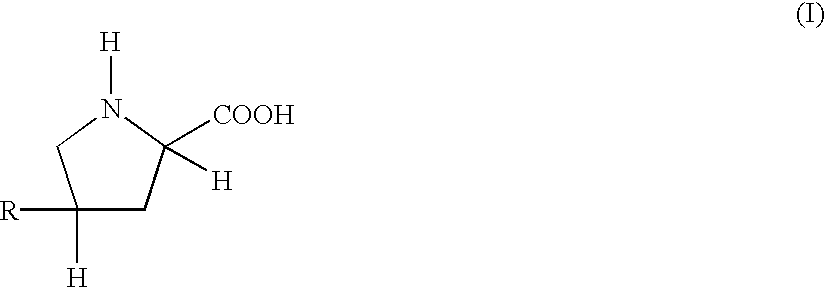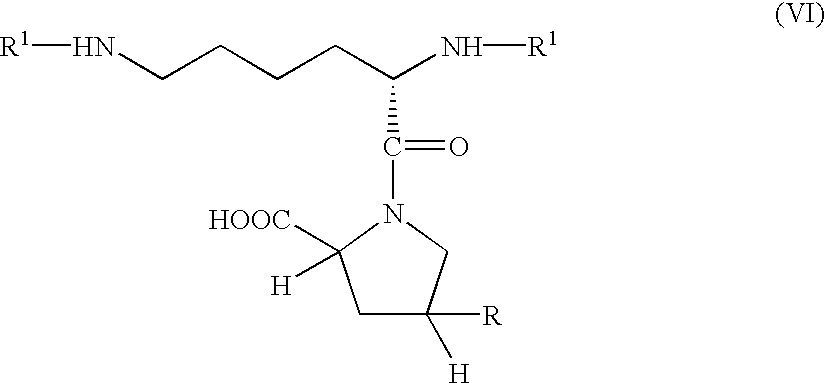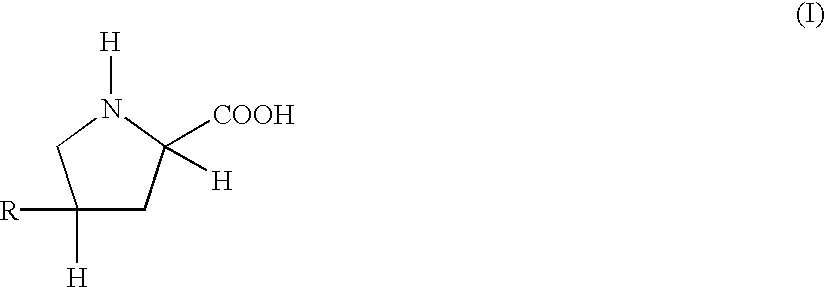Polymer compositions comprising antifibrotic agents, and methods of treatment, pharmaceutical compositions, and methods of preparation therefor
a technology of polymer compositions and antifibrotic agents, which is applied in the field of polymer compositions comprising antifibrotic agents, and methods of treatment, pharmaceutical compositions, and methods of preparation therefor, and can solve problems such as systemic obviation of excessive dosages
- Summary
- Abstract
- Description
- Claims
- Application Information
AI Technical Summary
Problems solved by technology
Method used
Image
Examples
example 2
Preparation of PEG-Lys Ethyl Ester Copolymer: Poly(PEG-Lys-OEt)
In a 500 mL three-necked round-bottomed flask fitted with an overhead stirrer was dissolved 1.1 g (4.4 mmol) of lysine ethyl ester hydrochloride salt (Fluka) and 1.7 g (21 mmol) of sodium bicarbonate in 100 mL of water. The PEG-N-hydroxy succinimide-dicarbonate of Example I (10 g, 4.4 meq) was dissolved in 200 mL of methylene chloride and added to the reaction mixture. The mixture was stirred vigorously (about 1100 rpm) for two hours and then acidified to about pH 2. The two phases were separated and the organic phase was washed twice with NaCl. The organic layer was then dried over anhydrous MgSO4, filtered and concentrated. The polymer was precipitated using cold ether, cooled to 40.degree. C. and filtered to recover 6.7 g (67%) of the polymer.
The crude polymer (500 mg) was dissolved in 10 mL of distilled water and dialyzed against distilled water at room temperature for 48 hours using a SPECTRAPOR(.TM.) membrane with ...
example 3
Preparation of PEG-Lys Copolymer: Poly(PEG-Lys)
The polymer of Example 2 (5 g) was dissolved in 5 mL of H.sub.2 O. The pH of the polymer solution was about 5 as measured with a pH meter. A 0.01N NaOH solution was prepared, and the base was added dropwise into the polymer solution with stirring. The pH was monitored continuously and kept around 11.5 by the addition of base as needed. The reaction was allowed to proceed for five hours, after which the reaction was stopped and the reaction mixture was acidified with 0.1 N HC1. The polymer was extracted into methylene chloride and the extract was washed with saturated NaCl, dried over anhydrous MgSO4, filtered and concentrated. The polymer was then precipitated with cold ether. After cooling for several hours, the product was collected in a Buchner funnel, washed with cold ether and dried under vacuum overnight, after which 3.5 g of polymer final product (71%) was recovered.
example 4
Preparation of Activated Poly(PEG-Lys)
In a 10 mL round-bottomed flask, 1.0 g (0.46 mmol) of the polymer of Example 3 was dissolved in 5 mL of methylene chloride. To this solution, 0.26 g of N-hydroxysuccinimide (Aldrich) (2.3 mmol) was added. The flask was cooled in an ice water bath and 0.10 g (0.50 mmol) of dicyclohexylcarbodiimide (DCC) (Aldrich) was added. The reaction mixture was then stirred at 0.degree. C. for one hour and then at room temperature overnight. The reaction mixture was filtered to remove dicyclohexyl urea and the methylene chlorine was evaporated to give a white, waxy material. Isopropanol (5 mL) was added and the mixture was stirred until a clear solution was obtained. Cooling to -15.degree. C. precipitated a white solid which was collected on a Buchner funnel and washed first with isopropanol and then with hexane. The material was further purified by recrystallization from isopropanol. The recovery of the final product was 0.72 g (71%).
PUM
| Property | Measurement | Unit |
|---|---|---|
| Fraction | aaaaa | aaaaa |
| Fraction | aaaaa | aaaaa |
| Temperature | aaaaa | aaaaa |
Abstract
Description
Claims
Application Information
 Login to View More
Login to View More - R&D
- Intellectual Property
- Life Sciences
- Materials
- Tech Scout
- Unparalleled Data Quality
- Higher Quality Content
- 60% Fewer Hallucinations
Browse by: Latest US Patents, China's latest patents, Technical Efficacy Thesaurus, Application Domain, Technology Topic, Popular Technical Reports.
© 2025 PatSnap. All rights reserved.Legal|Privacy policy|Modern Slavery Act Transparency Statement|Sitemap|About US| Contact US: help@patsnap.com



